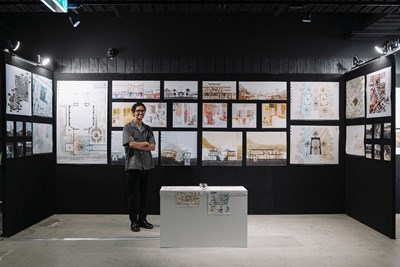Rishav Sarmah from Waipapa Taumata Rau, The University of Auckland, Te Pare School of Architecture and Planning is a finalist for his project '"Where You From?" Bridging the Cross-Cultural Identities of India and Aotearoa'.
Project description
This thesis was born from an introspection of my own identity as a second-generation Indian immigrant living in Aotearoa New Zealand, and the cultural insecurity that comes with living between two worlds. The design research investigates such ‘betweenness’ through the conception of a cross-cultural bridging of two architectural designs in Tāmaki Makaurau Auckland, and Assam, India.
Memory and its connection to the olfactory is the avenue by which this project was constructed. Research into the symbiotic relationship between memory and culture indicates that our cultural heritage shapes the way we remember things and our memories shape the way we view our cultural identity. The olfactory is significant in this interplay. The designs are constructed not by sight, but by a series of olfactory experiences derived from my memories as an Assamese person.
“Where You From?” is realised through two designs. Both designs are nondescript in program; emphasis is instead placed on the prioritisation of scent. The Chamber of Smells is an extension to the Bharatiya Mandir Hindu Temple in Sandringham, Tāmaki Makaurau Auckland; the Vidyapith Commune is an adaptive reuse project of a closed school opposite my grandparent’s home in Durgasarobar, Guwahati Assam.
Jury citation
From an introspective study of identity and cultural insecurity arises a joyful architectural response to investigating betweenness and the bridging of disparate worlds.
This thesis is a deeply personal exploration of duality, a difficult space for second-generation immigrants to navigate – a third space that takes courage to step into. The research into cultural identity shows depth and intelligence, with memory being the informing avenue.
Beautifully executed architectural interventions in each of these seemingly disparate worlds mirror each other, and both use the olfactory to stimulate memory and connection. Collage takes precedence – fragments of memory are extrapolated and layered to create understanding in their reference and interpretation.
Just like the sense of smell, this design proposition is sensitive and profound. Ultimately, it accepts and celebrates betweeness.














